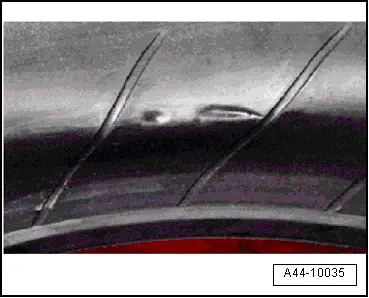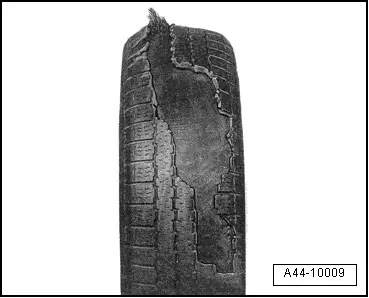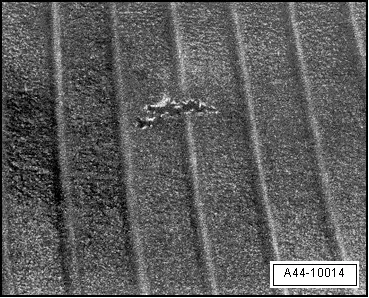Audi Q3: General Information
 Note
Note
Because tire damage can have serious consequences, the technician and the driver should regularly check the tires, as it is the best form of early problem recognition.
Pre-damaged tires cannot withstand driving situations like high vehicle speed, long driving distance, sporty driving style and similar situations.
Damage can occur from various causes:
- Driving with low tire pressure
- Mistakes during tire mounting
- Damage during run-in
- Aging
- Incorrect storage
 Caution
Caution
As soon as a safety risk cannot be ruled out, the tire must be replaced.
Tires, Examining
Pay special attention to the following criteria when examining the tire:
- Surface erosion or marbling on the inner side (pressure was too low or insufficient for the load).
- Detached rubber or loose cords.

- Exposed or deformed bead bundle.

- Damage to tire bead with visible cords.

Radial Tires, Construction
The illustration shows a cross section of a radial tire.

1 - Tread Block
2 - Tread Groove
3 - Tread
4 - Nylon Ply
5 - Radial Tires, Mostly Consist of Steel
6 - Bead Bundle
- Consists of steel wires vulcanized into rubber make sure that secure seating of the tire on the rim
7 - Bead Filler
8 - Wheel Flange Protection
- Protects the rim and tire from abrasion due to, for example, contact with the curb. Wheels with rim protection are identified with the abbreviation MFS
The nylon ply -4-, belt layers -5-, bead bundle -6- and bead filler -7- form the shell. The shell is the load-bearing structure of the tire.
Disintegrated Tread

Cracking
Cracking is the term for shallow cracks in the sidewall of the tire.
They run starting from the bulge in the direction of the tire shoulder.
The cause is the increase in material at the joints of the tire components.
Cracking has no effect on:
- Safety
- Service life
- Driving behavior or other tire characteristics
Cracks can be of varying visibility. Removing the tire from the rim or an examination is not necessary.
How did the cracks form?
Modern steel belted tires are constructed with single-ply sidewalls to save weight.
The sidewall components consist of long strips before they are joined together to form a tire. They must overlap at the joints. Small irregularities/ripples form in the area of the overlapping components. The overlaps are easier to see from the outside due to the single-ply construction.
Impact Damage
A swelling in the flank of the tire indicates that the substructure of the shell has been damaged.
Typical causes for such damage include, for example, driving over curbs at a sharp angle.
Pinching the shell of a tire this way can damage the shell.
The substructure of the tire is stretched so far that individual fibers in the shell may break.
The extent of the damage depends on the speed of impact, the angle of impact, the air pressure, the axle load and the type of obstacle.
Evidence of pinching in the tire side wall.
 Note
Note
- Driving over curbs must be avoided!
- When it cannot be avoided, curbs should be driven over very slowly at the bluntest possible angle.

Interior view of a tire with a punctured shell.
Due to a severe impact, the shell was pinched on the rim flange and is ruptured in the contact patch.

Double rupture caused by pinching when driving over a curb. Often not detectable from outside.

Cuts
Cuts caused by a sharp-edged obstacle.

Damage from Foreign Debris
Driving over hard, pointed objects like nails, screws and the like can pierce the tire.
This always leads to tire damage.
Frequently, the foreign object is so securely embedded in the tire that it will not free itself even at higher speeds. Due to this, it can act as a plug and seal the tire relatively well. The result is gradual loss of pressure which the driver does not notice immediately but which can lead to sudden and complete tire failure.

